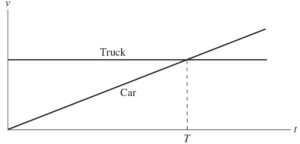Which of the following do not affect the maximum speed that a car can drive in a circle? Choose both correct answers.
A 15 g marble moves to the right at 3.5 m/s and makes an elastic head-on collision with a 22-g marble. The final velocity of the 22 g marble is 2.0 m/s to the right, and the final velocity of the 15 g marble is 5.4 m/s to the left. What was the initial velocity of the 22 g marble?
Consider a rigid body that is rotating. Which of the following is an accurate statement?
Two objects are dropped from rest from the same height. Object \( A \) falls through a distance \( d_A \) during a time \( t \), and object \( B \) falls through a distance \( d_B \) during a time \( 2t \). If air resistance is negligible, what is the relationship between \( d_A \) and \( d_B \)?
A rotating merry-go-round makes one complete revolution in 4.0 s. What is the linear speed and acceleration of a child seated 1.2 m from the center?
A drinking fountain projects water at an initial angle of \( 50^ \circ \) above the horizontal, and the water reaches a maximum height of \( 0.150 \) \( \text{m} \) above the point of exit. Assume air resistance is negligible.
A horizontal force of 110 N is applied to a 12 kg object, moving it 6 m on a horizontal surface where the kinetic friction coefficient is 0.25. The object then slides up a 17° inclined plane. Assuming the 110 N force is no longer acting on the incline, and the coefficient of kinetic friction there is 0.45, calculate the distance the object will slide on the incline.
A skier is accelerating down a \( 30.0^{\circ} \) hill at \( 3.80 \) \( \text{m/s}^2 \).

The motions of a car and a truck along a straight road are represented by the velocity-time graphs in the figure. The two vehicles are initially alongside each other at time t = 0. At time T, what is true of the distances traveled by the vehicles since time t = 0?
A 45 kg crate accelerates at 1.65 m/s2 when pulled by a rope with a force of 200 N. Find the angle the rope is pulled at. Friction is negligible.
| Speed | \( 10 \, \mathrm{m/s} \) | \( 20 \, \mathrm{m/s} \) | \( 30 \, \mathrm{m/s} \) |
| Braking Distance | \( 6.1 \, \mathrm{m} \) | \( 23.9 \, \mathrm{m} \) | \( 53.5 \, \mathrm{m} \) |
A car of mass \( 1500 \, \mathrm{kg} \) is traveling at one of the speeds listed when the brakes are first applied. Using the data above, what is the magnitude of the average braking force required to stop the car?
A pendulum consists of a mass \( M \) hanging at the bottom end of a massless rod of length \( \ell \) which has a frictionless pivot at its top end. A mass \( m \), moving with velocity \( v \), impacts \( M \) and becomes embedded. In terms of the given variables and constants, what is the smallest value of \( v \) sufficient to cause the pendulum (with embedded mass \( m \)) to swing clear over the top of its arc?
By continuing you (1) agree to our Terms of Sale and Terms of Use and (2) consent to sharing your IP and browser information used by this site’s security protocols as outlined in our Privacy Policy.
Quick Start Guide
AP physics 1, AP C, honors and advanced physics students.
Quickly filter questions by units and more.


Here’s guide to using 5 UBQ filters.
GQ = general question, MCQ = multiple choice, FRQ = free response.


Click the check or bookmark button.
Now you’ll be able to see completed or bookmarked questions at a glance!
Answer keys, personalized for you.

Phy will be responsible for grading your FRQs and GQs.
No more copy and pasting. Just solve and snap.
Questions for Mastery

By continuing you agree to nerd-notes.com Terms of Service, Privacy Policy, and our usage of user data.